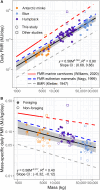Life in the slowest lane: Feeding allometry lowers metabolic rate scaling in the largest whales
- PMID: 40768593
- PMCID: PMC12327476
- DOI: 10.1126/sciadv.adw2232
Life in the slowest lane: Feeding allometry lowers metabolic rate scaling in the largest whales
Abstract
The hypothesized impacts of whale foraging on ocean productivity are ultimately defined by their metabolic rate, but determining energy expenditure for ocean giants remains challenging. The largest baleen whales use a high-drag lunge-feeding strategy that is hypothesized to come at a high energetic cost, thus requiring exceptional calorie intake. We used biologging tags to measure respiratory rates in foraging rorquals and demonstrate that their field metabolic rates are less than half that predicted by prey consumption estimates and by scaling predictions from smaller marine mammals. The relative cost of rorqual foraging decreases with increasing size as larger whales spend disproportionately longer time filtering prey from engulfed water. By decoupling active swimming and filtration, the largest rorquals forage with limited movement costs. The evolution of lunge feeding confers an energetic advantage that is unique among filter feeders and may have provided an evolutionary pathway to the largest body sizes.
Figures



References
-
- Kleiber M., Body size and metabolism. Hilgardia 6, 316–352 (1932).
-
- M. Kleiber, The Fire of Life. An Introduction to Animal Energetics. (John Wiley & Sons, Inc., New York; 1961).
-
- R. H. Peters, The Ecological Implications of Body Size (Cambridge Univ. Press, 1983) Cambridge Studies in Ecology.
-
- K. Schmidt-Nielsen, Scaling: Why Is Animal Size so Important? (Cambridge Univ. Press, 1984).
-
- Brown J. H., Burger J. R., Hou C., Hall C. A. S., The pace of life: Metabolic energy, biological time, and life history. Integr. Comp. Biol., icac058 (2022). - PubMed
MeSH terms
LinkOut - more resources
Full Text Sources

